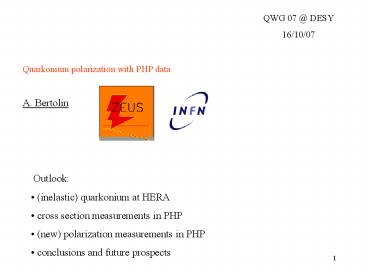Quarkonium polarization with PHP data - PowerPoint PPT Presentation
Title:
Quarkonium polarization with PHP data
Description:
(inelastic) quarkonium at HERA. cross section measurements in PHP ... (inelastic) quarkonium at HERA. PHP low Q2 electron escape undetected ... – PowerPoint PPT presentation
Number of Views:44
Avg rating:3.0/5.0
Title: Quarkonium polarization with PHP data
1
QWG 07 _at_ DESY 16/10/07
Quarkonium polarization with PHP data A.
Bertolin
- Outlook
- (inelastic) quarkonium at HERA
- cross section measurements in PHP
- (new) polarization measurements in PHP
- conclusions and future prospects
2
- (inelastic) quarkonium at HERA
J/y
- PHP Û low Q2 Û electron escape undetected
- inelastic Û accompanying final state hadrons
3
z E(J/y) / E(g) p rest frame
- (inelastic) quarkonium at HERA
direct g, CS model 0.2 lt z lt 0.9
resolved g, CS model z lt 0.2
- direct g, CO model
- this particular diagram
- 0.2 lt z lt 0.9
- more typical ones
- z gt 0.9
diffractive contributions suppressed by cuts
on the main kinematic quantities
4
- cross section measurements in PHP
- no strong conclusion because of the large
normalization uncertainties of the theoretical
predictions
5
- polarization measurements (helicity parameters)
- study of the polar and azimuthal decay angular
distribution of J/y mesons - in general the m decay angular distribution in
the J/? rest frame is parameterized as - (M. Beneke, M. Kramer and M. Vanttinen, Phys.
Rev. D 57, 4258 (1998)) - d2s/dWdy µ 1 ?(y) cos2 ? µ(y) sin 2? cos f
½ ?(y) sin2 ? cos 2f - where y stands for a set of variables (z and
pt(J/y) are good candidates) - ?, µ, ? are related to the different color-octet
matrix elements involved - ?, µ, ? also depend on the definition of a
coordinate system
main advantage Since the decay angular
distribution parameters are normalized, the
dependence on parameters that affect the absolute
normalization of cross sections, such as mc, as,
mR, mF and parton distribution, cancels to a
large extent and does not constitute a
significant uncertainty Þ main source of
theoretical uncertainties gone
main disadvantage for every y bin we have to fit
a distribution Þ unlikely requires large
statistics
6
- polarization measurements (helicity parameters)
- integrate the helicity master formula
- in f
- 1/s d2s/dcos ? dy µ 1 ?(y) cos2 ?
- in cos ?
- 1/s d2s/dcos ? dy µ 1 1/3 ?(y) 1/3 ?(y) cos
2f - which frame ? frame accessible experimentally
using PHP events target frame - z axis (quantization axis) along the opposite
of the incoming proton direction in the J/y rest
frame - x and y axis chosen to complete a right-handed
coordinate system in the J/y rest frame according
to some conventions we were given by the
theorists - different helicity of the lepton beam does not
matter as long as the proton beam is unpolarized
(always true at HERA) - q angle between the m vector in the J/y rest
frame and the z axis - f azimuthal angle in the x-y plane of the m
vector in the J/y rest frame
7
- polarization measurements (helicity parameters)
- data NOT corrected for
- B J/y ( m m- ) anything
- very small contribution at HERA
- y(2S) J/y ( m m- ) anything
s(2S)/ s(1S) 0.33 0.10 (stat.) 0.01 0.02
(sys.) BR(2S 1S anything) (55.7 2.6)
PDG y(2S) J/y anything / J/y 15 dilute
the polarization
38 pb-1 lt 1/10 of what we have now
- experimentally it is very difficult to perform
reliably these corrections
8
- (new) polarization measurements in PHP
- 0.4 lt z lt 1
- high pT region difficult to access at HERA
9
- (new) polarization measurements in PHP
- pT gt 1 GeV
- l good agreement between data and (degenerous)
theory - n do not see the positive values expected in
the CS model
10
- conclusions
- the ZEUS helicity measurement has been updated
with all the HERA available stat. - n seems to be the more interesting parameter in
order to access the size of the color octet
matrix elements at HERA - hopefully this measurement will be converted
soon to a journal paper may try to improve the
sys. with some more work - ZEUS helicity data are compared to a LO
prediction can the theory be improved in this
respect ? - can we have predictions also in the kt approach
? - later on we plan a paper on J/y differential
cross sections (PHP and DIS)































